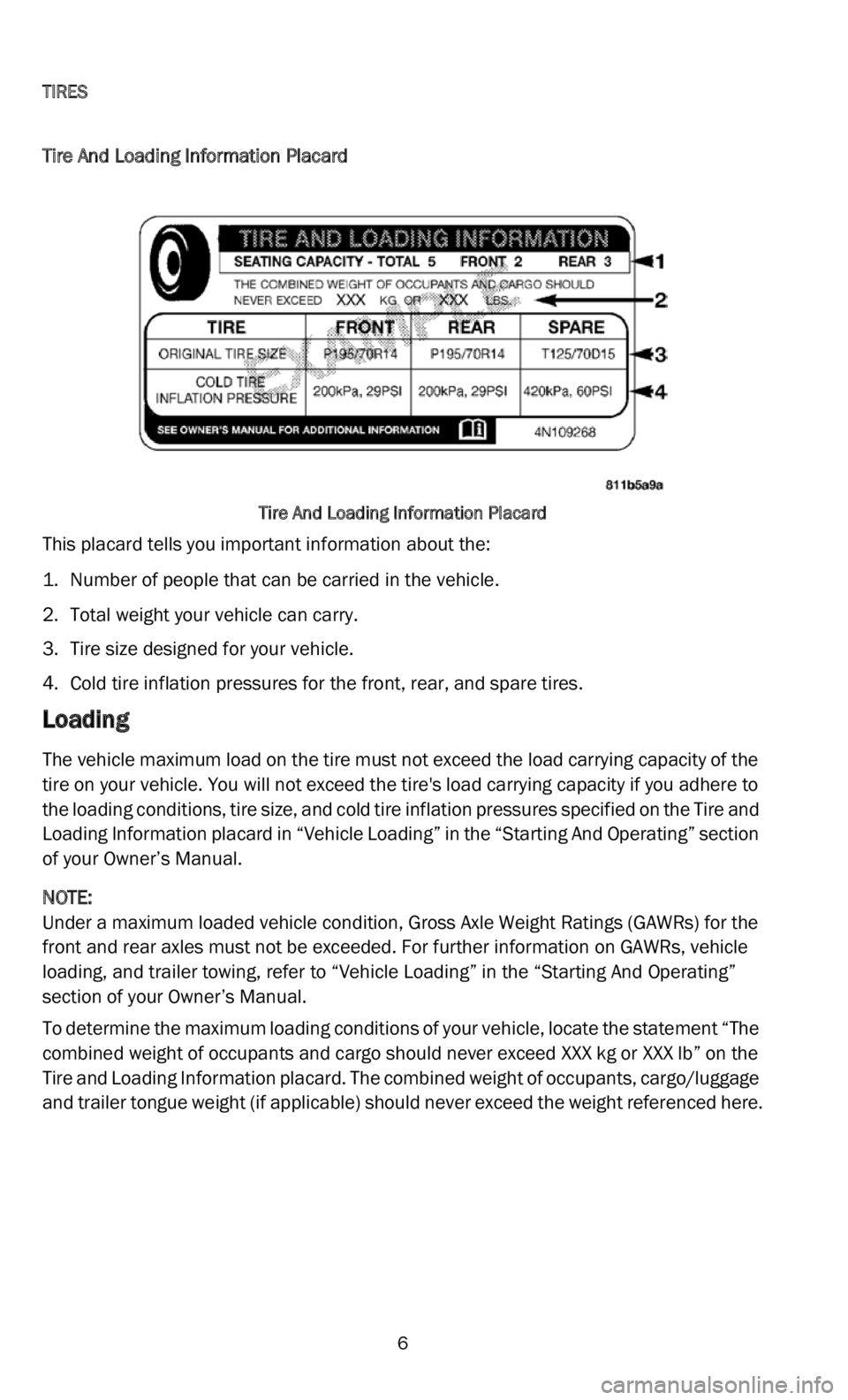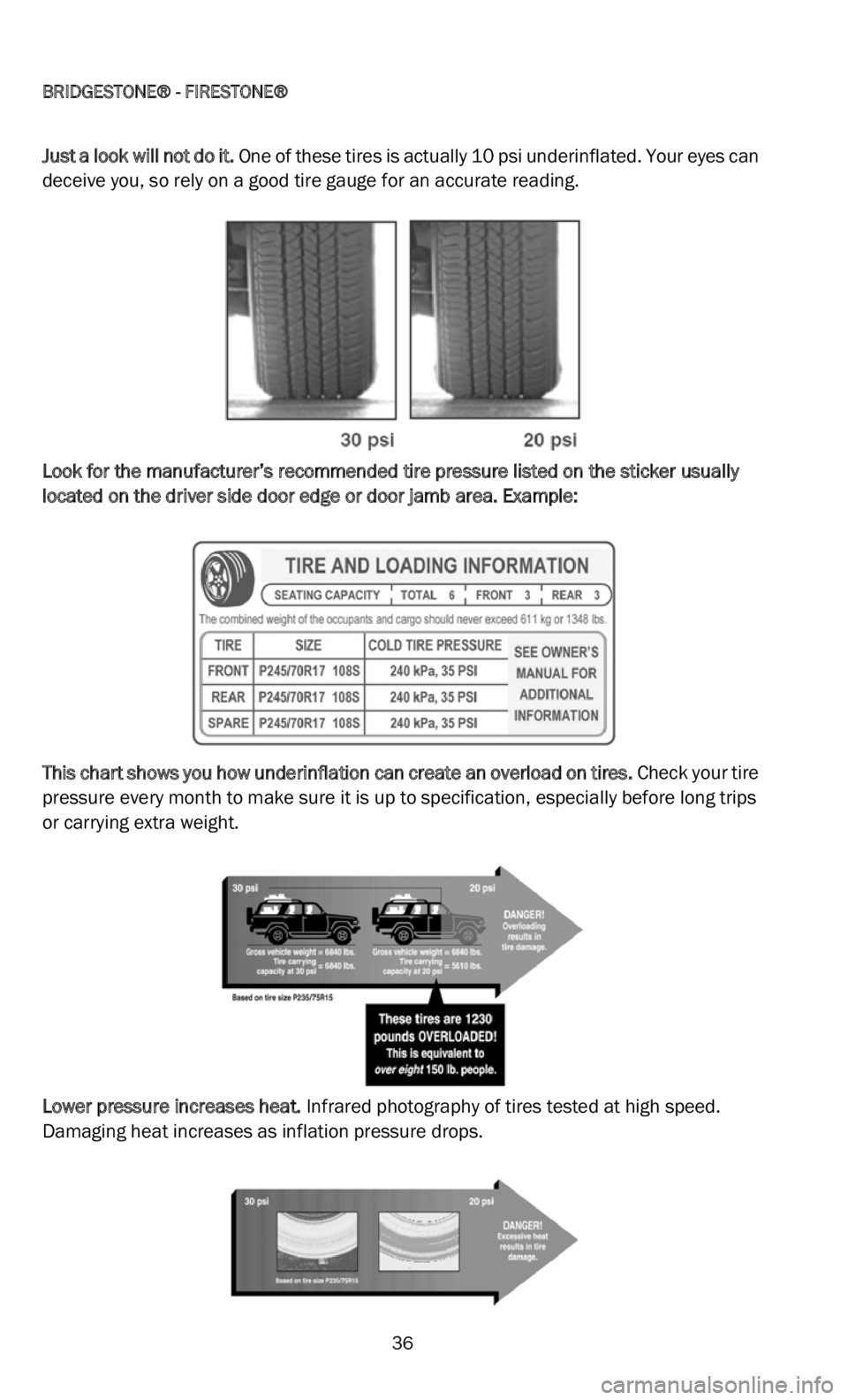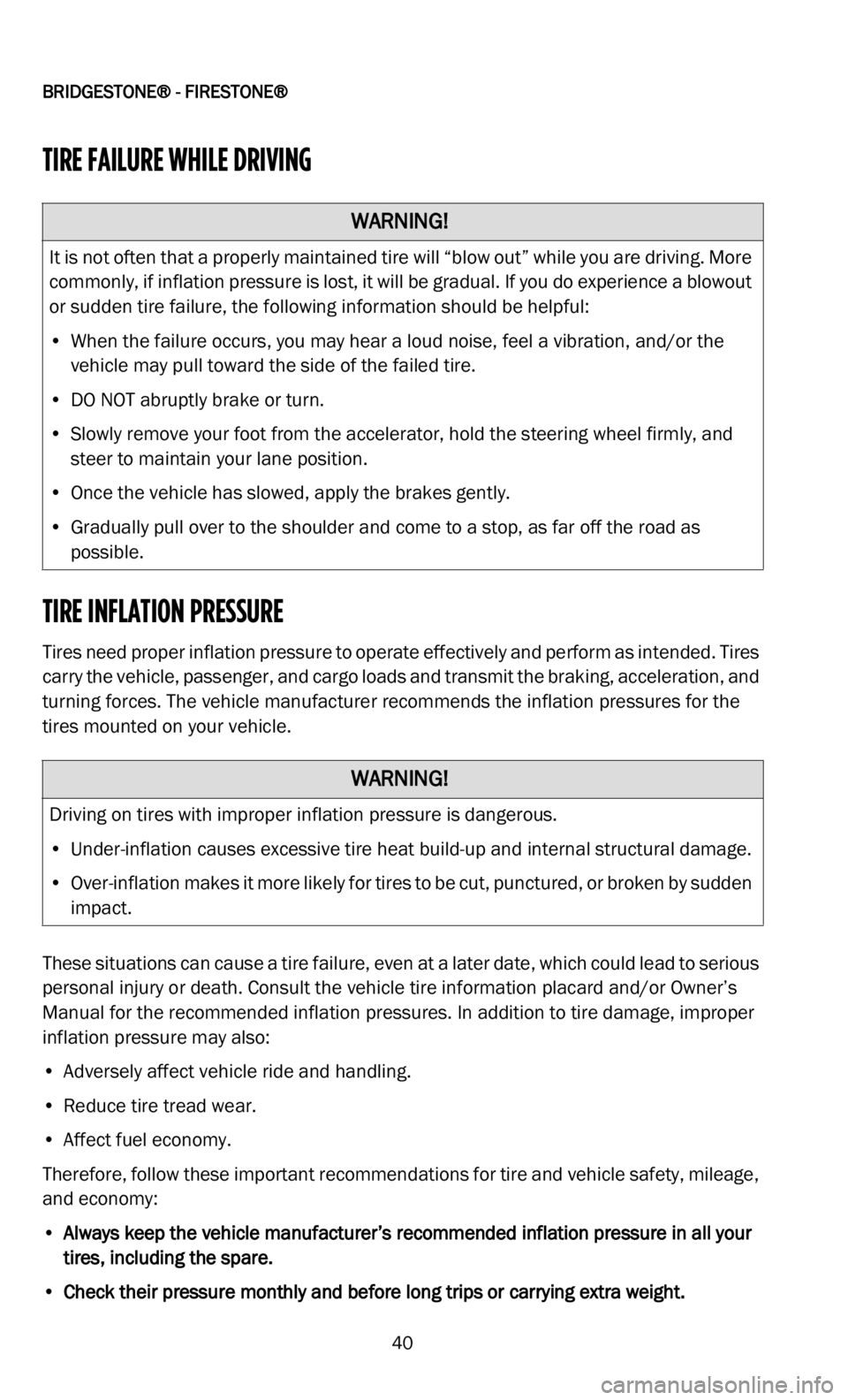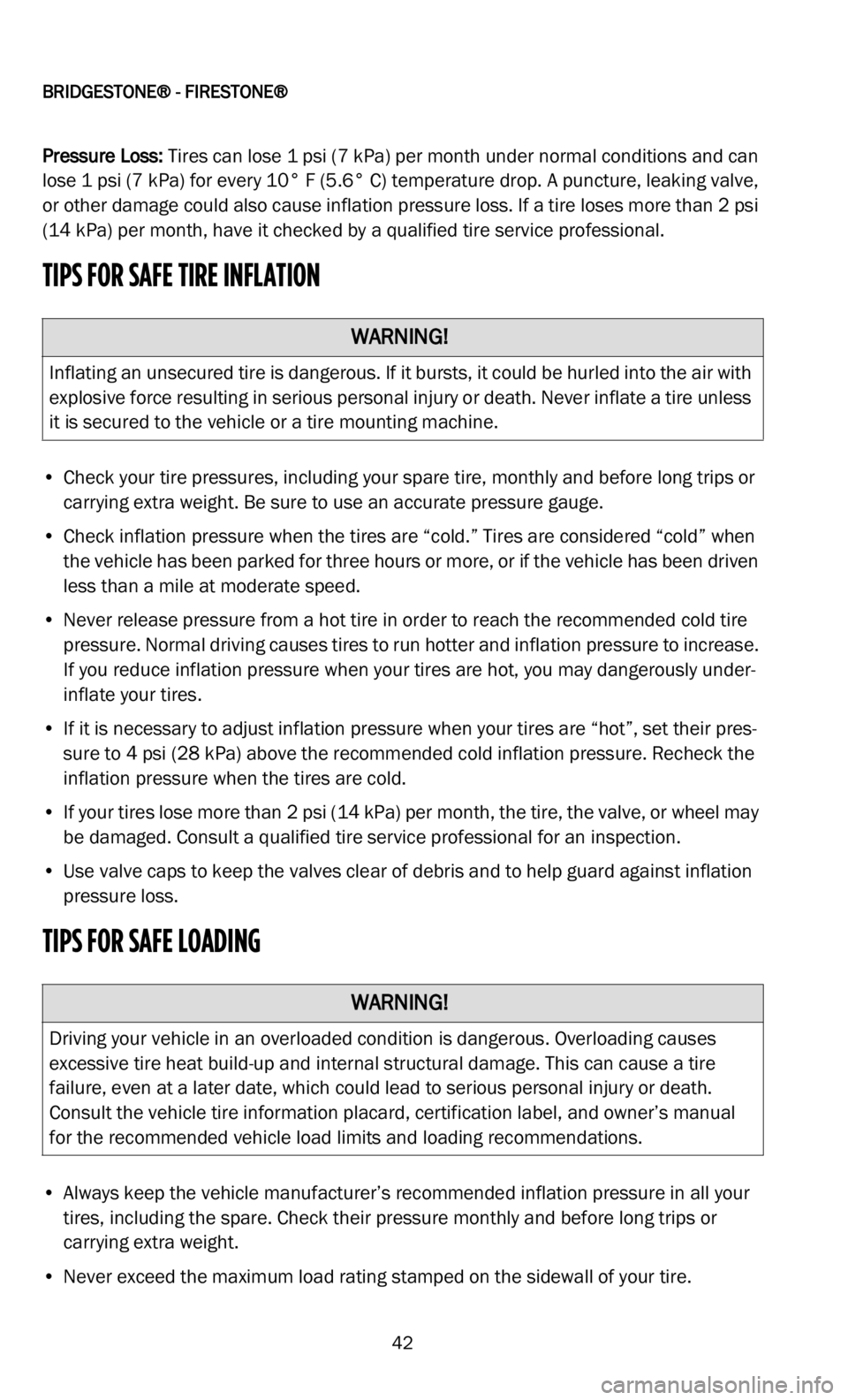weight DODGE DURANGO 2022 Vehicle Warranty
[x] Cancel search | Manufacturer: DODGE, Model Year: 2022, Model line: DURANGO, Model: DODGE DURANGO 2022Pages: 200, PDF Size: 6.72 MB
Page 7 of 200

TIRES
6
Tire And Loading Information Placard
Tire And Loading Information Placard
This placard tells you important information about the:
1. Number of people that can be carried in the vehicle.
2.
Total weight your vehicle can carry.
3 .
Tire size designed for your vehicle.
4 .
Cold tire inflation pressures for the front, rear, and spare tires.
Loading
The vehicle maximum load on the tire must not exceed the load carrying capacity of the
tire on your vehicle. You will not exceed the tire's load carrying capacity if you adhere to
the loading conditions, tire size, and cold tire inflation pressures specified on the Tire and
Loading Information placard in “Vehicle Loading” in the “Starting And Operating” section
of your Owner’s Manual.
NOTE:
Under a maximum loaded vehicle condition, Gross Axle Weight Ratings (GAWRs) for the
f r o
nt and rear axles must not be exceeded. For further information on GAWRs, vehicle
loading, and trailer towing, refer to “Vehicle Loading” in the “Starting And Operating”
section of your Owner’s Manual.
To determine the maximum loading conditions of your vehicle, locate the statement “The
co m
bined weight of occupants and cargo should never exceed XXX kg or XXX lb” on the
Tire and Loading Information placard. The combined weight of occupants, cargo/luggage
and trailer tongue weight (if applicable) should never exceed the weight referenced here.
Page 8 of 200

TIRES
7
Steps For Determining Correct Load Limit—
(1) Locate the statement “The combined weight of occupants and cargo should never
ex c
eed XXX kg or XXX lb” on your vehicle's placard.
(2) Determine the combined weight of the driver and passengers that will be riding in
yo u
r vehicle.
(3) Subtract the combined weight of the driver and passengers from XXX kg or
XXX lb.
(4) The resulting figure equals the available amount of cargo and luggage load capacity.
Fo r
example, if “XXX” amount equals 1,400 lb and there will be five 150 lb passengers
in your vehicle, the amount of available cargo and luggage load capacity is 650 lb
(1,400-750 (5x150) = 650 lb).
(5) Determine the combined weight of luggage and cargo being loaded on the vehicle.
Th a
t weight may not exceed the available cargo and luggage load capacity calculated in
Step 4.
(6) If your vehicle will be towing a trailer, the load from your trailer will be transferred to
yo u
r vehicle. Consult this manual to determine how this reduces the available cargo and
luggage load capacity of your vehicle.
Metric Example For Load Limit
For example, as shown in step 4 above, if “XXX” amount equals 635 kg and there will be
fi v
e 68 kg passengers in your vehicle, the amount of available cargo and luggage load
capacity is 295 kg (635-340 (5x68) = 295 kg).
NOTE:
• If your vehicle will be towing a trailer, the load from your trailer will be transferred to yo
ur vehicle. The following table shows examples on how to calculate total load,
cargo/luggage, and towing capacities of your vehicle with varying seating configura -
tions and number and size of occupants. This table is for illustration purposes only and
ma y
not be accurate for the seating and load carrying capacity of your vehicle.
• For the following example, the combined weight of occupants and cargo should never ex
ceed 865 lb (392 kg).
Page 29 of 200

BFGOODRICH® TIRES
28
All tires will wear out faster when subjected to high speeds as well as hard cornering,
rapid starts, sudden stops, frequent driving on roads which are in poor condition, and off
road use. Roads with holes and rocks or other objects can damage tires and cause
misalignment of your vehicle. When driving on such roads, drive carefully and slowly, and
before driving again at normal or highway speeds, examine your tires for any damage,
such as cuts, bulges, penetrations, unusual wear patterns, etc.
WEAR BARS
BFGoodrich® tires contain “Wear-Bars” in the grooves of the tire tread which show up
when only 2/32 of an inch (1.6 mm) of tread is remaining. At this stage, your tires must
b e
replaced. Tires worn beyond this stage are extremely dangerous.
DO NOT OVERLOAD - DRIVING ON ANY OVERLOADED TIRE IS DANGEROUS
The maximum load rating of your tires is molded on the tire sidewall. Do not exceed this
ra
ting. Follow the loading instructions of FCA US LLC and this will ensure that your tires
are not overloaded. Tires which are loaded beyond their maximum allowable loads for
the particular application will build up excessive heat that may result in sudden tire
destruction.
Do not exceed the Gross Axle Weight Rating (GAWR) for any axle on your vehicle.
TRAILER TOWING
If you anticipate towing a trailer, you should visit any BFGoodrich® tire retailer for advice
concerning the correct size tire and pressures. Tire size and pressures will depend upon
the type and size of trailer and hitch utilized, but in no case must the maximum cold
inflation pressure or tire load rating be exceeded. Check the tire decal and the Owner’s
Manual supplied by FCA US LLC for further recommendations on trailer towing.
WHEEL ALIGNMENT AND BALANCING ARE IMPORTANT FOR SAFETY AND MAXIMUM
MI
LEAGE FROM YOUR TIRES
CHECK HOW YOUR TIRES ARE WEARING AT LEAST ONCE EACH MONTH
If your tires are wearing unevenly, such as the inside shoulder of the tire wearing faster
th
an the rest of the tread, or if you detect excessive vibration, your vehicle may be out of
alignment or balance. These conditions not only shorten the life of your tires but
adversely affect the handling characteristics of your vehicle, which could be dangerous.
If you detect irregular wear or vibration, have your alignment and balance checked
immediately. Tires which have been run underinflated will show more wear on the
shoulders than in the center of the tread.
TIRE MIXING
BFGoodrich® tires are radial tires and for best performance it is recommended that the
same size and type of tire be used on all four wheel positions. Before mixing tires of
different types in any configuration on any vehicle, be sure to check the vehicle
manufacturer’s Owner‘s Manual for its recommendations.
Page 31 of 200

BFGOODRICH® TIRES
30
REPLACEMENT OF TWO TIRES
It is recommended that all four tires are replaced at the same time. However, whenever
on
ly two tires are replaced, the new ones should be put on the rear. The new tires, with
deeper tread, may provide better grip and water evacuation in wet driving conditions.
CUSTOMIZATION OF TIRES, WHEELS, OR SUSPENSION ON SUVS AND LIGHT
TRUCKS
Due to their size, weight and higher center of gravity, vehicles such as SUVs and light
trucks do not
have the same handling characteristics as automobiles. Because of these
differing characteristics, failure to operate your SUV/truck in a proper and safe manner
can increase the likelihood of vehicle rollover. Modifications to your SUV/truck tire size,
tire type, wheels or suspension can change its handling characteristics and further
increase the likelihood of vehicle rollover. Whether your SUV/truck has the original
equipment configuration for tires, wheels and suspension or whether any of these items
have been modified, always drive safely, avoid sudden, sharp turns or lane changes and
obey all traffic laws. Failure to do so may result in loss of vehicle control leading to an
accident and serious injury or death.
TIRE ALTERATIONS
Do not make or allow to be made any alterations on your tires. Alterations may prevent
p r
oper performance, leading to tire damage which can result in an accident. Tires which
become unserviceable due to alterations such as trueing, whitewall inlays, addition of
balancing or sealant liquids, or the use of tire dressing containing petroleum distillates
are excluded from warranty coverage.
REPAIRS - WHEREVER POSSIBLE, SEE YOUR BFGOODRICH® TIRE RETAILER AT ONCE
If any BFGoodrich® tire sustains a puncture, have the tire demounted and thoroughly
i n
spected by any BFGoodrich® tire retailer for possible damage that may have occurred.
A tread area puncture in any BFGoodrich® passenger or light truck tire can be repaired
p r
ovided that the puncture hole is not more than 1/4 of an inch in diameter, not more
than one radial cable per casing ply is damaged, and the tire has not been damaged
further by the puncturing object or by running underinflated. Tire punctures consistent
with these guidelines can be repaired by following the Rubber Manufacturers Association
(RMA) recommended repair procedures.
TIRE REPAIRS
Repairs of all tires must be of the combined plug and inside patch type. Plug only repairs
are improper. A tire should be removed from the rim and inspected prior to repair. Any
tire repair done without removing the tire from the rim is improper. An improperly
repaired tire will cause further damage to the tire by either leaking air or allowing air,
moisture and contaminants to enter the structure of the tire. An improperly repaired tire
can fail suddenly at a later date.
Never repair a tire with less than 2/32 of an inch tread remaining. At this tread depth,
t h
e tire is worn out and must be replaced.
Page 32 of 200

BFGOODRICH® TIRES
31
TEMPORARY SPARE TIRES
When using any temporary spare tire, be sure to follow the vehicle manufacturer’s
instructions.
READING THE DOT
DOT XXXX XXXX XXX (prior to August 2000)
DOT XXXX XXXX XXX (1990-1999)
DOT XXXX XXXX XXXX (after July 2000)
THE DOT
The “DOT” symbol certifies tire manufacturer’s compliance with US Department of
T r
ansportation (DOT) tire safety standards. Next to the symbol is the tire identification or
“serial number”. The first two characters identify the plant where the tire was
manufactured. The next two characters reflect the tire size. The following one to four
digits may be used at the tire manufacturer’s option as a descriptive code. The last three
characters are numbers identifying the week and year of manufacture. Example: “O25”
means second week of the year of decade, eg.: 1995, 1985, etc. Tires produced after
July 2000 have an additional digit to identify a given decade. For example, 2800 means
th
e tire was produced during the 28th week of 2000; 0201 during the 2nd week of 2001.
If the last digits of your DOT number contain three numeric characters consult a qualified
tire technician to determine the year and decade of manufacture.
STORAGE
Tires contain waxes and emollients to protect their outer surfaces from ozone and
weather checking. As the tire rolls and flexes, the waxes and emollients continually
migrate to the surface, replenishing this protection throughout the normal use of the tire.
Consequently, when tires sit outdoors, unused for long periods of time (a month or more)
their surfaces become dry and more susceptible to ozone and weather checking and the
casing becomes susceptible to flat spotting.
For this reason, tires should always be stored in a cool, dry, clean, indoor environment.
I f
storage is for one month or more, eliminate the weight from the tires by raising the
vehicle or by removing the tires from the vehicle. Failure to store tires in accordance with
these instructions could result in damage to your tires or premature aging of the tires and
sudden tire failure.
When tires are stored, be sure they are placed away from sources of heat and ozone such
as
hot pipes and electric generators. Be sure that surfaces on which tires are stored are
clean and free from grease, gasoline or other substances which could deteriorate the
rubber. (Tires exposed to these materials during storage or driving could be subject to
sudden failure.)
Page 37 of 200

BRIDGESTONE® - FIRESTONE®
36
Just a look will not do it. One of these tires is actually 10 psi underinflated. Your eyes can
deceive you, so rely on a good tire gauge for an accurate reading.
Look for the manufacturer’s recommended tire pressure listed on the sticker usually
lo
cated on the driver side door edge or door jamb area. Example:
This chart shows you how underinflation can create an overload on tires. C
heck your tire
pressure every month to make sure it is up to specification, especially before long trips
or carrying extra weight.
Lower pressure increases heat. I
nfrared photography of tires tested at high speed.
Damaging heat increases as inflation pressure drops.
Page 41 of 200

BRIDGESTONE® - FIRESTONE®
40
TIRE FAILURE WHILE DRIVING
TIRE INFLATION PRESSURE
Tires need proper inflation pressure to operate effectively and perform as intended. Tires
carry the vehicle, passenger, and cargo loads and transmit the braking, acceleration, and
turning forces. The vehicle manufacturer recommends the inflation pressures for the
tires mounted on your vehicle.
These situations can cause a tire failure, even at a later date, which could lead to serious
pe
rsonal injury or death. Consult the vehicle tire information placard and/or Owner’s
Manual for the recommended inflation pressures. In addition to tire damage, improper
inflation pressure may also:
• A dversely affect vehicle ride and handling.
•
Reduce tire tread wear.
•
Affect fuel economy.
T
herefore, follow these important recommendations for tire and vehicle safety, mileage,
a n
d economy:
• Always keep the vehicle manufacturer’s recommended inflation pressure in all your
t
ires, including the spare.
• Check their pressure monthly and before long trips or carrying extra weight.
WARNING!
It is not often that a properly maintained tire will “blow out” while you are driving. More
commonly, if inflation pressure is lost, it will be gradual. If you do experience a blowout
or sudden tire failure, the following information should be helpful:
• W hen the failure occurs, you may hear a loud noise, feel a vibration, and/or the
v
ehicle may pull toward the side of the failed tire.
• D O NOT abruptly brake or turn.
•
Slowly remove your foot from the accelerator, hold the steering wheel firmly, and
s
teer to maintain your lane position.
• O nce the vehicle has slowed, apply the brakes gently.
•
Gradually pull over to the shoulder and come to a stop, as far off the road as
p
ossible.
WARNING!
Driving on tires with improper inflation pressure is dangerous.
• U nder-inflation causes excessive tire heat build-up and internal structural damage.
•
Over-inflation makes it more likely for tires to be cut, punctured, or broken by sudden
i
mpact.
Page 43 of 200

BRIDGESTONE® - FIRESTONE®
42
Pressure Loss: Tires can lose 1 psi (7 kPa) per month under normal conditions and can
lose 1 psi (7 kPa) for every 10° F (5.6° C) temperature drop. A puncture, leaking valve,
or other damage could also cause inflation pressure loss. If a tire loses more than 2 psi
(14 kPa) per month, have it checked by a qualified tire service professional.
TIPS FOR SAFE TIRE INFLATION
• Check your tire pressures, including your spare tire, monthly and before long trips or carrying extra weight. Be sure to use an accurate pressure gauge.
• C heck inflation pressure when the tires are “cold.” Tires are considered “cold” when
t
he vehicle has been parked for three hours or more, or if the vehicle has been driven
less than a mile at moderate speed.
• N ever release pressure from a hot tire in order to reach the recommended cold tire
p
ressure. Normal driving causes tires to run hotter and inflation pressure to increase.
If you reduce inflation pressure when your tires are hot, you may dangerously under -
inflate your tires.
• I f it is necessary to adjust inflation pressure when your tires are “hot”, set their pres -
s
ure to 4 psi (28 kPa) above the recommended cold inflation pressure. Recheck the
i n
flation pressure when the tires are cold.
• I f your tires lose more than 2 psi (14 kPa) per month, the tire, the valve, or wheel may
b
e damaged. Consult a qualified tire service professional for an inspection.
• U se valve caps to keep the valves clear of debris and to help guard against inflation
p
ressure loss.
TIPS FOR SAFE LOADING
• Always keep the vehicle manufacturer’s recommended inflation pressure in all your tires, including the spare. Check their pressure monthly and before long trips or
carrying extra weight.
• N ever exceed the maximum load rating stamped on the sidewall of your tire.
WARNING!
Inflating an unsecured tire is dangerous. If it bursts, it could be hurled into the air with
explosive force resulting in serious personal injury or death. Never inflate a tire unless
it is secured to the vehicle or a tire mounting machine.
WARNING!
Driving your vehicle in an overloaded condition is dangerous. Overloading causes
excessive tire heat build-up and internal structural damage. This can cause a tire
failure, even at a later date, which could lead to serious personal injury or death.
Consult the vehicle tire information placard, certification label, and owner’s manual
for the recommended vehicle load limits and loading recommendations.
Page 44 of 200

BRIDGESTONE® - FIRESTONE®
43
• Never exceed the Gross Vehicle Weight Rating (GVWR) or front/rear Gross Axle Weight Rating (GAWR) of your vehicle.
• C onsult your vehicle Owner’s Manual for load recommendations and special instruc -
t
ions such as for trailer/towing and snow plow installations.
TIRE DAMAGE, INSPECTION AND SERVICE LIFE
Evaluation and maintenance of your tires is important to their performance and the
service they provide to you. Over time and/or through use, the condition of a tire can
change from exposure to everyday road conditions, the environment, damaging events
such as punctures, and other external factors.
You should visually inspect your tires on a regular basis throughout their life, and you
sh
ould have your tires periodically evaluated by a qualified tire service professional when
your vehicle is serviced such as routine maintenance intervals, oil changes, and tire
rotations. In particular, note the following tips for spotting tire damage:
• A fter striking anything unusual in the roadway, have a qualified tire service profes -
s
ional demount the tire and inspect it for damage. A tire may not have visible signs of
d a
mage on the tire surface. Yet, the tire may suddenly fail without warning, a day, a
week, or even months later.
• I nspect your tires for cuts, cracks, splits or bruises in the tread and sidewall areas.
B
umps or bulges may indicate a separation within the tire body. Have your tire
inspected by a qualified tire service professional. It may be necessary to have it
removed from the wheel for a complete inspection.
• I nspect your tires for adequate tread depth. When the tire is worn to the built-in indi -
c
ators at 2/32 of an inch (1.6 mm) or less tread groove depth, or the tire cord or fabric
i s
exposed, the tire is dangerously worn and must be replaced immediately.
• I nspect your tires for uneven wear. Wear on one side of the tread or flat spots in the
t
read may indicate a problem with the tire or vehicle. Consult a qualified tire service
professional.
• I nspect your wheels also. If you have a bent or cracked wheel, it must be replaced.
•
Don’t forget to check the spare tire.
M
ake sure your tires, including the spare tire, continue to be regularly inspected after 5
y e
ars of service to determine if they can continue in service. Even when your tires appear
to be usable from their external appearance or the tread depth may have not reached
the minimum wear out depth, it is recommended that all tires (including spare tires and
“temporary use” spares) more than 10 years old be replaced with new tires.
WARNING!
Driving on damaged tires is dangerous. A damaged tire can suddenly fail causing
serious personal injury or death. Have your tires regularly inspected by a qualified tire
service professional.
Page 55 of 200

BRIDGESTONE® - FIRESTONE®
54
TIRE REGISTRATION
Registration of your tires is an important safety precaution since it enables the
manufacturer to notify you in the event of a recall. When you purchase replacement tires,
the retailer will provide a registration card on which the tire identification numbers have
been recorded; fill in your name and address on the card and mail it promptly. Some
retailers may submit the registration for you. You do not need to register tires which come
as original equipment on new vehicles—the vehicle and tire manufacturers handle that
for you.
RFT TIRES WITH RUN-FLAT TECHNOLOGY
If your vehicle is equipped with Bridgestone® or Firestone® brand RFT
tires, this chapter presents specific maintenance and safety issues
a s
sociated with these tires that are in addition to those covered elsewhere in this
manual.
What is RFT? Run-Flat Technology tires are extraordinary tires that utilize specially
d e
signed components to temporarily support your vehicle in the event of inflation
pressure loss, such as from a puncture. This gives you the ability to drive to a convenient
and safe location to change your tire (if equipped with a spare) or have it inspected for
possible repair or replacement.
Naturally, certain run-flat and low pressure operating limitations apply, which varies
ac
cording to the specific self-supporting tire design. Like all tires, during normal
operation, they must be properly inflated and maintained. Regardless of the design or
quality, no tire is indestructible.
RFT — How to Identify: B
ridgestone® and Firestone® brand tires are marked on the
sidewalls, near the wheel, with the RFT logo (shown above).
RFT INFLATION PRESSURE
Like other tires, RFT tires need proper inflation pressure maintenance for safe operation
an
d to achieve the maximum tire life and performance. Check inflation pressures
monthly and before long trips or carrying extra weight. Use an accurate tire gauge and
check pressures when the tires are cold. Follow the vehicle manufacturer’s
recommendation for inflation pressure settings as indicated on the vehicle tire
information placard and/or in the vehicle Owner’s Manual. Do not forget the spare, if
applicable. See “Tire Inflation Pressure” in this manual.
TIRE PRESSURE MONITORING SYSTEM (TPMS)
A functioning Tire Pressure Monitoring System (TPMS) must be used with your Run Flat
tires. These tires ride so well even without inflation pressure, the TPMS may be necessary
to alert you of an inflation pressure loss condition. When alerted, follow the instructions
in your vehicle Owner’s Manual and see “Run-Flat or Low Tire Pressure Operation,” the
following section in this manual.